Every file that we have saved on our computers has a particular extension. The file extension is added at the end of the filename followed by a dot (.). It tells the operating systems about the structure of the file so that the OS could select the right software or application to open that file. You might have seen some files on your computer that do not have any file extension or file type. How do you open such types of files? In this article, we will see how to open a file with no extension in Windows 11/10.

When it comes to opening a file on a Windows OS, there are three ways that a user can try:
- Right-click on the file and select Open.
- Select the file you want to open and hit Enter.
- Double-click on the file that you want to open.
To open a file, you should have the right program installed on your system. For example, if you want to open an Excel file, you should have a program that supports the excel file, like Microsoft Excel, Apache Open Office, Libre Office, etc. If you want to open a PDF file, you should have a PDF reader or a web browser to open the PDF file.
What if you come across a file with no extension? In this case, none of the above three methods work to open that file. To open the files with no extensions, first, you have to identify their extension or type. After identifying their extension, install the right program on your computer to open that file.
To know the file extension or file type, switch the view mode in File Explorer to Details. After switching to the Details view, you will see the file extension of all the files in the Type column. Another way to know the file extension is via the file properties. Right-click on the file, the extension of which you want to know, and select Properties. After that, select the General tab and you will be able to view the type of file.
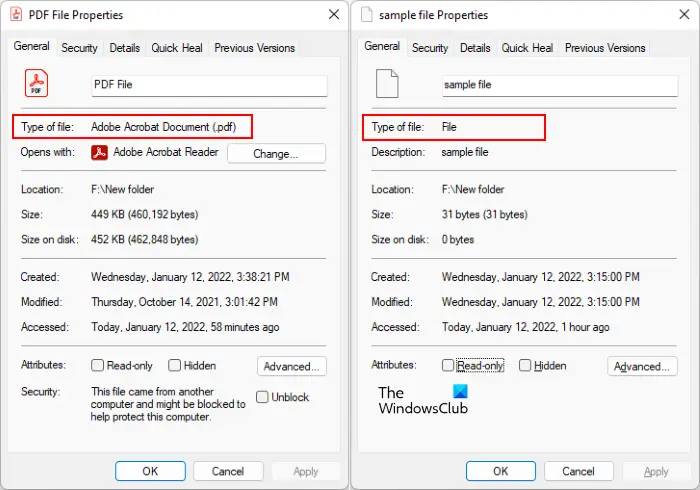
If you view the properties of the file with an unknown extension, you will see File as its file extension.
How to open a file with no extension in Windows 11/10
There are some free file identifier tools that let you know the extensions of the unknown file types. We have listed some of these tools below.
- FILExt
- File Identifier from Toolsley
- CheckFileType Online
- Detect File Type
- Online TrID File Identifier
- FileInfo.com.
Let’s see how to use these free file identifier tools.
1] FILExt
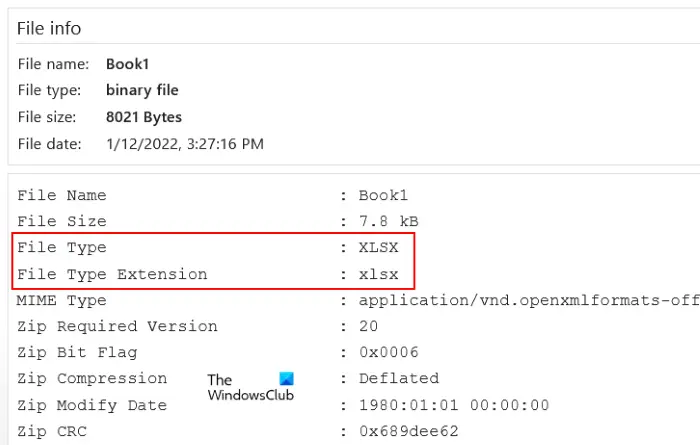
FILExt is a free online file identifier tool that lets users identify the extensions of unknown file types. This free tool is easy to use. First visit its official website, filext.com, then scroll down the page till you find the Choose your file button. Now, click on that button and select the file from your computer to upload it to the website. Alternatively, you can also upload the files via the drag n drop method.
After uploading the file, FILExt automatically starts analyzing it and generates its preview. The preview will show you the content the file contains. If you scroll down the page, you will see its file extension. After knowing the file type, you can download it in that format by clicking on the Save as button, provided that file format is available in the Save as list.
Read: Free Universal File Viewer software for Windows.
2] File Identifier from Toolsley
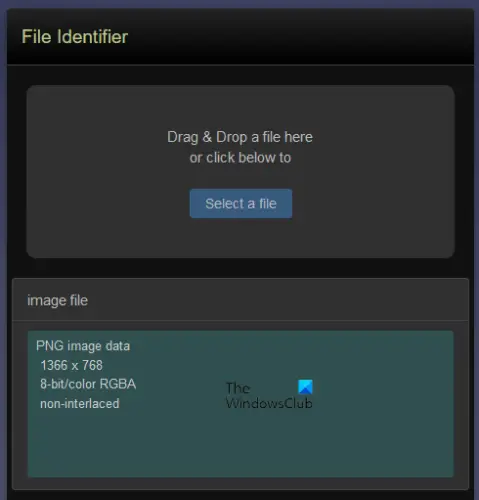
File Identifier from Toolsley is another free tool to identify the type of file. To use this tool, you have to visit its official website toolsley.com/file.html. After visiting the website, the next step is to upload the file with an unknown extension. For this, click on the Select a file button or simply upload the files by the drag & drop method. After uploading the file, File Identifier will automatically start analyzing it and show its extension.
3] CheckFileType Online
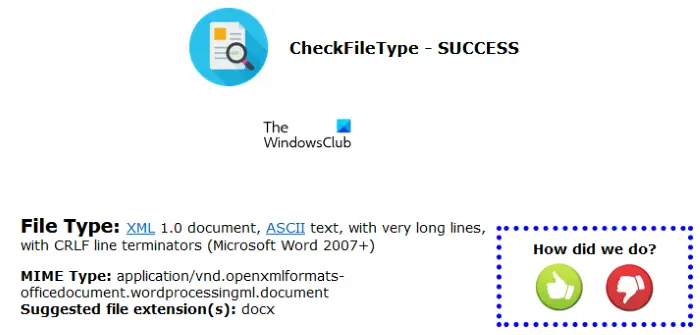
CheckFileType Online is one more free file identifier tool on this list that lets you find the file extension. Using this tool is simple. To use this tool, follow the below instructions:
- Visit CheckFileType Online official website, checkfiletype.com.
- Drag the file with an unknown extension and drop it into the box provided on the website. Alternatively, click anywhere inside the box and select the file from your computer to upload it to the website. Do note that the maximum upload size of the file is 16 MB.
- After uploading the file, click on the Check File Type button. A new tab will open, where the extension of the uploaded file is displayed.
Read: Files and folders suddenly disappeared in Windows.
4] Detect File Type
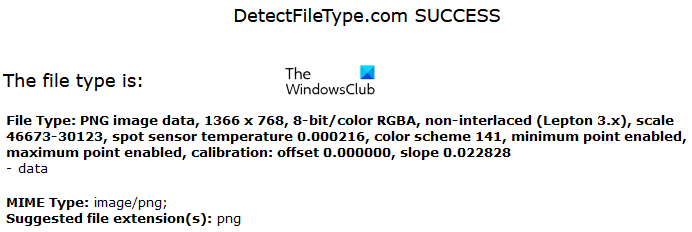
Detect File Type lets you detect the extension of a file with an incorrect or unknown extension. To use this free tool, first, visit its website, then upload the file by clicking on the Browse button. After uploading the file, click on the Detect File Type button. As you click on the Detect File Type button, the tool will open a new tab in your web browser, where you will see the suggested file type and file extension.
The Detect File Type tool is available on detectfiletype.com.
5] Online TrID File Identifier
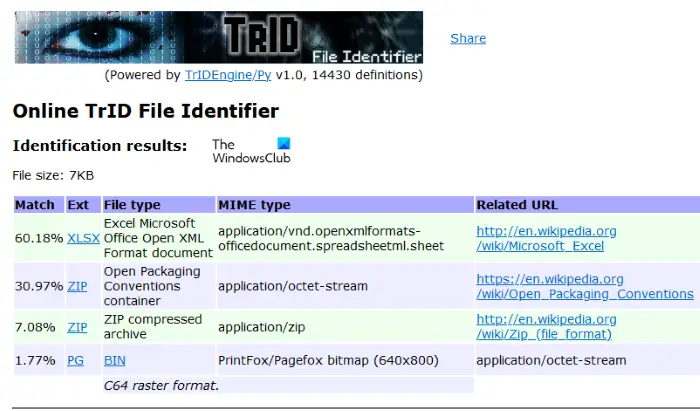
Online TrID File Identifier shows the possible file extensions of the uploaded file with percentage. After visiting the website, you have to click on the Browse button to upload the file and then click on the Start button to begin file analysis. The file which you are going to upload should be less than 10 MB in size.
Online TrID File Identifier is available on mark0.net/onlinetrid.html. This free tool is also available as a standalone installer. You can download it and install it on your system.
These are some of the free online file identifier tools that will help you identify the file type or extension. After knowing the file extension, you can easily download and install the appropriate software or search for the online tools to open that file.
6] FileInfo.com
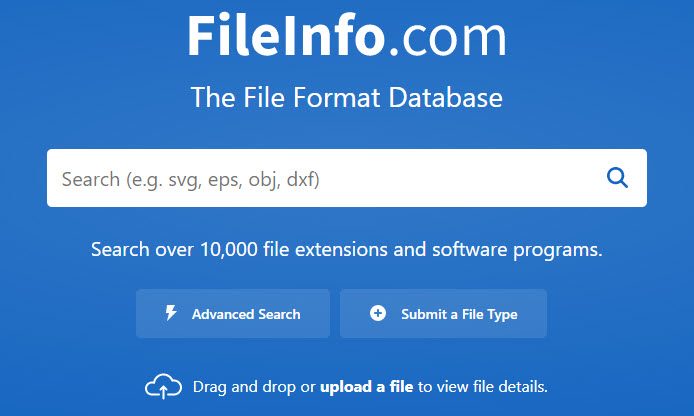
This site allows users to drag and drop a file onto the site’s home page to identify the file’s type. FileInfo.com not only identifies a file’s type, but tells a user what programs they can use to open the file.
Read: You have been denied permission to access this folder.
How do I enable file extensions in Windows 11?
To show file extensions in Windows 11, you just have to change the view mode in File Explorer. The steps are as follows:
- Open the File Explorer.
- Go to “View > Details.”
After selecting the Details view, you will be able to see the file extensions in the Type column.
If you do not want to change the view mode in File Explorer, you can enable the file extension by following the below-listed steps:
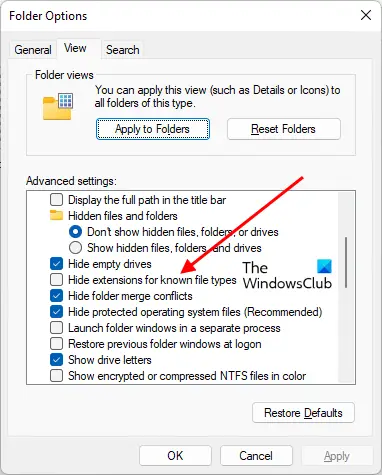
- Open File Explorer.
- Click on the three horizontal dots on the ribbon and select Options.
- Select the View tab and uncheck the Hide extensions for unknown file types option.
- Click Apply and then OK.
After that, Windows 11 will show the file extensions in every view mode you select.
How do I enable file extensions in Windows 10?
The methods to enable file extensions in Windows 10 are the same as in Windows 11 but the steps are a bit different in both of these operating systems. You either have to change the View mode or turn off the Hide file extensions option.
To change the view mode in Windows 11, simply open the File Explorer and go to “View > Details.” After switching the view mode to Details, you will be able to see the file extensions under the Type column.
Another way to enable the file extensions is turning off the Hide file extensions in Folder Options. The steps are as follows:
- Open the File Explorer.
- Click on the View menu and go to “Options > Change folder and search options.” This will open the Folder Options window.
- Now, select the View tab and uncheck the Hide extensions for unknown file types option.
- Click Apply and then OK. This will enable the file extensions in Windows 10.
I hope this helps.
Read next: How to create a file without Extension in Windows.